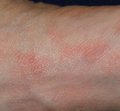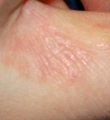Scabies
Scabies is a transmissible ectoparasite skin infection characterized by superficial burrows, intense pruritus (itching) and secondary infection. The word 'scabies' is Latin for 'itch'. more...
Etiology
Caused by the mite Sarcoptes scabiei, variety hominis, it produces intense, itchy skin rashes when the impregnated female tunnels into the stratum corneum of the skin and deposits eggs in the burrow. The larvae, which hatch in 3-10 days, move about on the skin, molt into a "nymphal" stage, and then mature into adult mites. The adult mites live 3-4 weeks in the host's skin.
The motion of the mite in and on the skin produces an intense itch which may resemble an allergic reaction in appearance. The presence of the eggs produces a massive allergic response which, in turn, produces more itching.
Scabies is transmitted readily, often throughout an entire household, by prolonged skin-to-skin contact with an infected person (e.g. bed partners), and thus is sometimes classed as a sexually transmitted disease. Spread by clothing, bedding or towels is a less significant risk, though possible.
Signs, Symptoms, and Diagnosis
A delayed hypersensitivity (allergic) response resulting in a papular eruption (red, elevated area on skin) often occurs 30-40 days after there may be hundreds of papules, less than 10 burrows are typically found. The burrow appears as a fine, wavy and slightly scaly line a few millimeters to one centimeter long. A tiny mite (0.3 to 0.4 mm) may sometimes be seen at the end of the burrow. Most burrows occur in the webs of fingers, flexing surfaces of the wrists, around elbows and armpits, the areolae of the breasts in females and on genitals of males, along the belt line, and on the lower buttocks. The face usually does not become involved in adults.
The rash may become secondarily infected; scratching the rash may break the skin and make secondary infection more likely. In persons with severely reduced immunity, such as those with HIV infection, or people being treated with immunosuppressive drugs like steroids, a widespread rash with thick scaling may result. This variety of scabies is called Norwegian scabies.
Scabies is frequently misdiagnosed as intense pruritis (itching of healthy skin) before papular eruptions form. Upon initial pruritus the burrows appear as small, barely noticeable bumps on the hands and may be slightly shiny and dark in color rather than red. Initially the itching may not exactly correlate to the location of these bumps. As the infestation progresses, these bumps become more red in color.
Generally diagnosis is made by finding burrows, which often may be difficult because they are scarce, because they are obscured by scratch marks, or by secondary dermatitis (unrelated skin irritation). If burrows are not found in the primary areas known to be affected, the entire skin surface of the body should be examined.
Read more at Wikipedia.org




